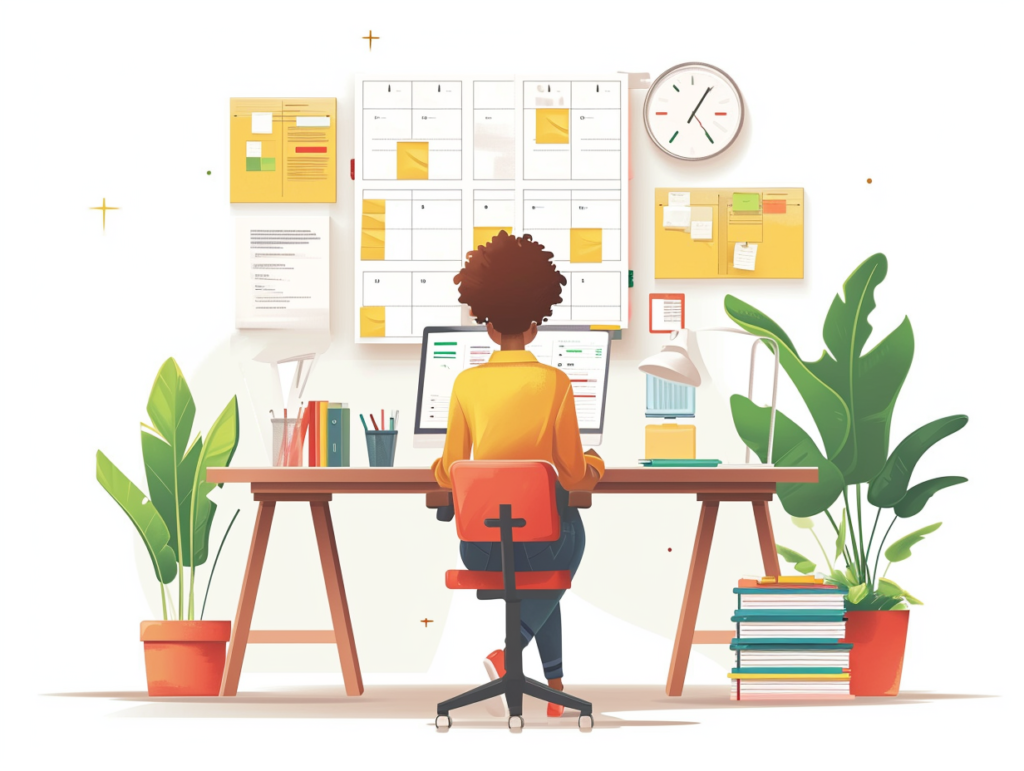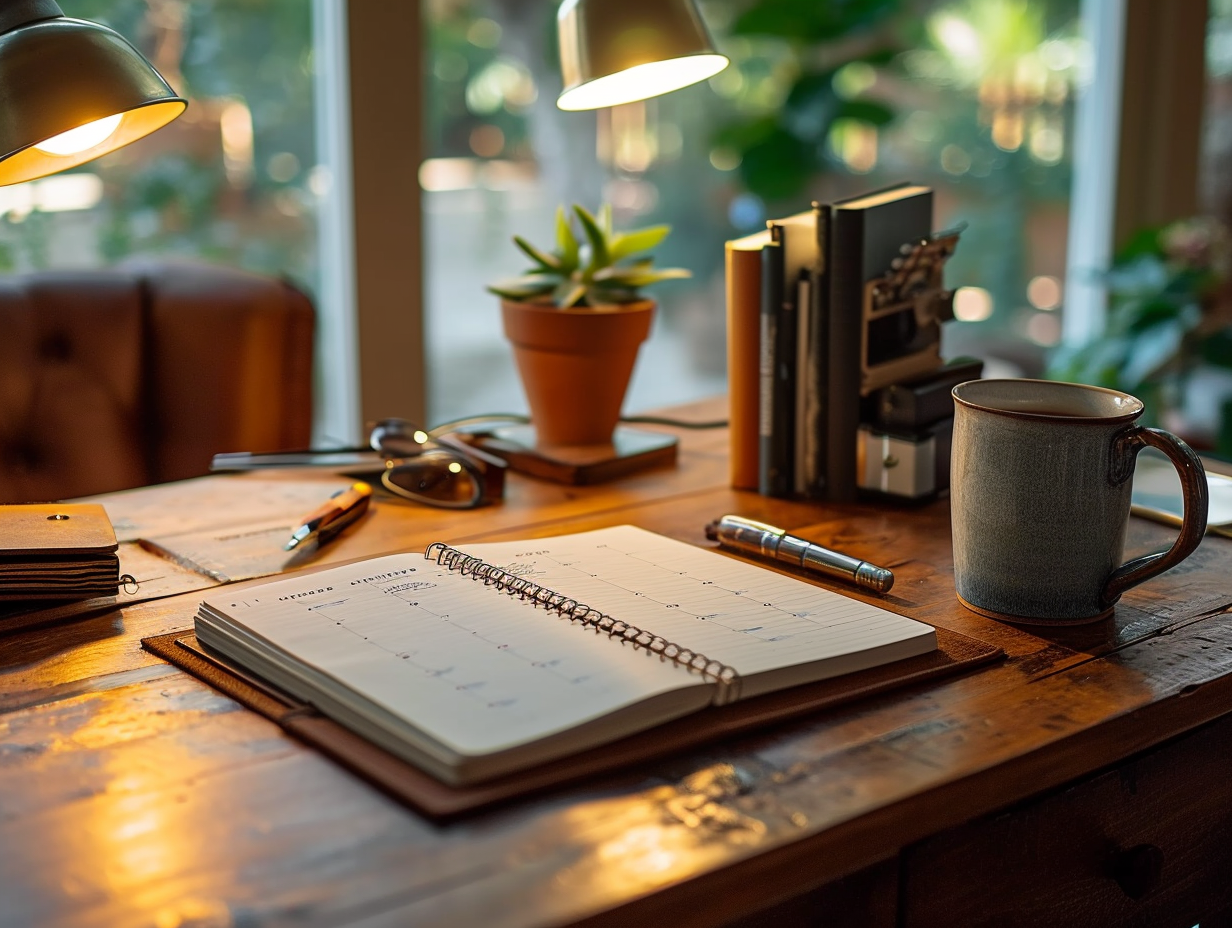In the realm of personal organization and productivity, an Hourly Daily Planner stands out as a game-changer. For anyone juggling multiple tasks, appointments, and goals, an Hourly Daily Planner is not just a tool; it’s a roadmap to success. In this comprehensive guide, we’ll explore the unparalleled benefits of using an Hourly Daily Planner, how to select the right one for your needs, and tips to maximize its potential.
Understanding the Hourly Daily Planner
An Hourly Daily Planner is a type of planner that provides a detailed breakdown of your day into hourly segments. It is designed to help you plan and manage your time by allocating specific tasks, appointments, and activities to each hour. This level of granularity allows for meticulous scheduling and can be particularly useful for individuals with busy and structured daily routines. Here are some key features and benefits of an Hourly Daily Planner:
- Hourly Layout: The planner typically features a layout that spans the entire day, divided into hourly time slots from morning to evening. Each hour is represented, providing a clear and organized structure for your day.
- Detailed Scheduling: With hourly slots, you can plan your day down to the minute. This level of detail helps you allocate time for various activities, meetings, work sessions, and personal tasks.
- Effective Time Management: The hourly format allows you to prioritize tasks and allocate appropriate time for each one. It helps prevent overloading your schedule and ensures that you have enough time for essential activities.
- Meeting and Appointment Planning: Hourly planners are particularly useful for professionals who have frequent meetings, appointments, or time-bound commitments. You can easily slot these events into your schedule and avoid scheduling conflicts.
- Task Tracking: You can use the hourly slots to track your progress on tasks throughout the day. This visual representation helps you stay on top of your to-do list and make adjustments as needed.
- Time Blocking: Time blocking is a popular productivity technique that works well with hourly planners. It involves assigning specific time blocks to different categories of tasks or projects, ensuring focused work during those periods.
- Flexibility: While hourly planners provide structure, they also offer flexibility. You can adjust your schedule as needed if unexpected events or changes arise.
- Visual Organization: The hourly layout allows for visual organization, making it easy to see your entire day at a glance. You can identify busy periods, free slots, and opportunities for breaks.
- Goal Alignment: You can align your daily schedule with your broader goals and priorities, ensuring that you allocate time to tasks that contribute to your long-term objectives.
- Time Awareness: Using an hourly planner encourages greater time awareness and mindfulness about how you use your hours, which can lead to improved time management and productivity.
Hourly Daily Planners are available in various formats, including physical paper planners and digital planning tools or apps. The choice between these formats depends on personal preference and the convenience of access to your planner throughout the day. Ultimately, an Hourly Daily Planner is a valuable tool for those who prefer a highly structured and organized approach to managing their time and tasks.
Why Use an Hourly Daily Planner?

The benefits of using an Hourly Daily Planner are manifold:
- Enhanced Time Management:
- Hourly planners offer a structured way to allocate your time throughout the day. This structured approach helps you visualize how you spend your time, making it easier to prioritize tasks and activities effectively.
- It allows you to identify time wastage and inefficiencies in your daily routine, helping you make adjustments for better time management.
- The hourly breakdown helps you plan for both short-duration tasks and longer projects, ensuring that everything fits into your schedule.
- Increased Productivity:
- When you plan your day hour by hour, you’re less likely to drift or get distracted. Each hour has a specific purpose, which can boost your productivity.
- The sense of structure and commitment to time slots can act as a motivator. It encourages you to stay on track and complete tasks as scheduled.
- The detailed schedule minimizes the chances of multitasking, which can lead to better focus and more efficient work.
- Reduced Stress:
- An Hourly Daily Planner provides a clear roadmap for your day, reducing uncertainty and the associated stress.
- By allocating time for tasks and activities in advance, you can avoid last-minute rushes, which are often a significant source of stress.
- It helps you balance work, personal life, and self-care, reducing the stress that comes from feeling overwhelmed or neglecting essential aspects of your life.
- Goal Tracking:
- Setting and monitoring short-term goals becomes more manageable with an hourly planner. You can break down larger objectives into smaller, actionable tasks.
- The hourly layout allows you to allocate specific time blocks for working toward your goals, ensuring that progress is made consistently.
- Tracking your achievements in your planner provides a visual record of your accomplishments, which can be motivating and satisfying.
- Improved Accountability:
- With an Hourly Daily Planner, you have a written record of how you planned your day. This can help you stay accountable to yourself and others.
- If you deviate from your schedule, it’s easier to identify where and why adjustments were necessary. This insight can lead to more effective planning in the future.
- Effective Prioritization:
- Hourly planners encourage you to prioritize tasks based on importance and urgency. You can allocate prime hours to critical tasks when your energy and focus are at their peak.
- By distinguishing between essential and less important activities, you can ensure that the most crucial tasks receive adequate attention.
- Enhanced Work-Life Balance:
- An Hourly Daily Planner allows you to allocate time for both work-related and personal activities. This balance can contribute to improved overall well-being and satisfaction.
- You can intentionally schedule breaks and downtime, preventing burnout and promoting relaxation.
In summary, the benefits of using an Hourly Daily Planner are multifaceted, encompassing improved time management, heightened productivity, reduced stress, effective goal tracking, enhanced accountability, better prioritization, and a healthier work-life balance. This tool empowers you to take control of your daily schedule and make the most of your time.
Choosing the Right Hourly Daily Planner
Selecting the right Hourly Daily Planner is crucial for effective time management and organization. To make the best choice, consider the following factors:
- Layout and Design:
- Evaluate the planner’s layout to ensure it aligns with your preferences and requirements. Some layouts may provide more space for hourly slots, while others may have additional sections for notes, goals, or to-do lists.
- Consider whether you prefer a vertical or horizontal hourly layout. Vertical layouts offer a more traditional hour-by-hour approach, while horizontal layouts may provide more space for each time slot.
- Look at the design and aesthetics of the planner. Choose one that resonates with your personal style and makes you want to use it daily.
- Size and Portability:
- Determine the size of the planner that suits your needs. Consider whether you want a compact, pocket-sized planner that’s easy to carry with you or a larger one with more writing space.
- Think about how and where you intend to use your planner. If you need to take it to meetings or classes, portability is crucial. If it’s mainly for desk use, a larger size may be acceptable.
- Paper Quality:
- Pay attention to the quality of the paper used in the planner. Thicker, high-quality paper is less likely to bleed through when you use pens or markers.
- Consider whether you prefer a planner with blank, lined, or grid paper for your hourly slots.
- Binding and Durability:
- Examine the binding of the planner. Spiral-bound, stitched, or ring-bound planners each have their advantages and may affect how the planner lays flat when open.
- Choose a planner with a durable cover that can withstand daily use and protect your pages.
- Additional Features:
- Some planners offer extra sections or features that can be valuable. These may include:
- Goal-setting pages for both short-term and long-term goals.
- Reflection or journaling sections for personal growth and mindfulness.
- To-do lists, habit trackers, or project planning pages.
- Monthly or yearly calendars in addition to the daily hourly layout.
- Some planners offer extra sections or features that can be valuable. These may include:
- Customization Options:
- Consider whether the planner allows for customization. Some planners come with stickers, tabs, or inserts that let you personalize your organization and make it more functional for your needs.
- Cost:
- Determine your budget for a planner. High-quality planners with premium features may come at a higher cost, so it’s essential to balance your preferences with your budget.
- Brand and Reviews:
- Research the planner’s brand and read reviews from other users to gain insights into the planner’s quality and functionality.
- Digital vs. Paper:
- Decide whether you prefer a physical paper planner or a digital planning tool or app. Both have their advantages, so choose the format that aligns with your preferences and lifestyle.
Ultimately, the right Hourly Daily Planner is a personal choice that depends on your unique needs, preferences, and daily routines. Consider how each of these factors aligns with your planning style and lifestyle to make an informed decision that will help you stay organized and productive.

How to Effectively Use an Hourly Daily Planner
Effectively using an Hourly Daily Planner can greatly enhance your time management and productivity. Here are some additional tips and strategies to make the most of your hourly planner:
- Set Clear Goals and Objectives:
- Before you start filling in your planner, have a clear understanding of your daily, weekly, and long-term goals. Your tasks and activities should align with these objectives.
- Morning Planning Routine:
- Start your day by reviewing your planner. Check your schedule, tasks, and appointments for the day. This sets the tone for a productive day.
- Prioritize Tasks:
- As mentioned, prioritize your tasks based on importance and urgency. Identify the most critical tasks that must be completed during the day. These should take priority in your hourly schedule.
- Time Blocking:
- Use the time-blocking technique to allocate specific time slots to different types of tasks or projects. For example, dedicate focused work blocks for complex tasks and shorter intervals for emails and administrative work.
- Buffer Time:
- Include buffer time between tasks and appointments to account for unexpected delays or to give yourself a breather. Overloading your schedule can lead to stress and reduce flexibility.
- Avoid Overcommitting:
- Be realistic about what you can accomplish in a day. Avoid the temptation to fill every hour with tasks. Leave some free time for flexibility and to handle unexpected issues.
- Stay Flexible:
- While it’s essential to have a structured schedule, be flexible when necessary. Sometimes, unexpected tasks or opportunities arise, and you may need to adjust your plan.
- Time Management Techniques:
- Combine your hourly planner with effective time management techniques such as the Pomodoro Technique (working in focused intervals) or the 2-Minute Rule (tackle small tasks immediately).
- Regular Check-Ins:
- Periodically review your hourly planner throughout the day. Check off completed tasks and adjust your schedule if you’re ahead or behind. This helps you stay on track.
- Utilize Reminders:
- If you use digital planners or apps, set reminders for important appointments and tasks. These can help ensure that you don’t forget critical items on your schedule.
- End-of-Day Review:
- At the end of the day, review your planner to assess what you accomplished and what’s left for the next day. Consider transferring unfinished tasks or rescheduling them.
- Reflect and Learn:
- Use your planner for personal reflection. Note what went well and what could have been done better. Use this feedback to improve your planning and time management skills over time.
- Consistency is Key:
- Make using your Hourly Daily Planner a consistent habit. The more you use it, the more effective it becomes in helping you manage your time and achieve your goals.
- Integrate Personal and Professional:
- If you have personal and professional responsibilities, integrate them into a single planner to ensure a balanced schedule.
- Stay Adaptable:
- Life is dynamic, and plans can change. Be adaptable and open to adjusting your schedule as needed while keeping your overall goals in mind.
By following these tips and incorporating effective time management strategies, you can make the most of your Hourly Daily Planner and increase your productivity and efficiency in managing your daily tasks and responsibilities.
Conclusion
The Hourly Daily Planner is a powerful tool for anyone looking to take control of their time and increase productivity. By choosing the right planner and using it effectively, you can transform your daily routine into a well-oiled productivity machine.









Leave a reply